Pomerol is a paradox. Its famous plateau terroir is hallowed; it produces (in Petrus, Le Pin and Château Lafleur) three of the most expensive wines in the world; demand is so high and quantities so small that it is very difficult to source back vintages; and its mere mention sends the pulses of Bordeaux aficionados racing.
Scroll down for Colin Hay’s three-step Pomerol selection
Yet the landscape of the appellation itself appears flat and uninspiring (a stark contrast to the calcareous contours of its immediate neighbour St-Emilion), there are no grand châteaux here, no visitor centres, no hotels, no cavistes and scarcely a restaurant.
It would be utterly forgettable were it not for the quality of its wines, and it belies entirely the adage that beautiful wines come only from beautiful places.
{"content":"PHA+SXQgaXMgdGhlIG9ubHkgYXBwZWxsYXRpb24gb2YgQm9yZGVhdXjigJlzIOKAmHRvcCBmaXZl4oCZIHRvIGhhdmUgbm8gc3lzdGVtIG9mIGNsYXNzaWZpY2F0aW9uIGFuZCBpdCB3YXMgc2NhcmNlbHkga25vd24gYmVmb3JlIHRoZSBwb3N0LXdhciBwZXJpb2QsIHRob3VnaCBpdCB3YXMgaW4gZmFjdCBvbmUgb2YgdGhlIG9yaWdpbmFsIGFwcGVsbGF0aW9ucyB0byBiZSBjcmVhdGVkIGJ5IEZyYW5jZeKAmXMgTmF0aW9uYWwgSW5zdGl0dXRlIGZvciBPcmlnaW4gYW5kIFF1YWxpdHkgKElOQU8pIGluIDE5MzYuIEl0IGlzIGFyZ3VhYmx5IHRoZSBtb3N0IGludGltYXRlIGFuZCB3ZWxjb21pbmcgb2YgQm9yZGVhdXjigJlzIGdyZWF0IGFwcGVsbGF0aW9ucywgYnV0IHRvIHRoZSB1bmluaXRpYXRlZCBpdCBpcyBhbHNvIHRoZSBtb3N0IGludGltaWRhdGluZy4gSXQgaXMsIHRvIG1pc3F1b3RlIENodXJjaGlsbCwgYSByaWRkbGUsIHdyYXBwZWQgaW4gYSBteXN0ZXJ5LCBpbnNpZGUgYW4gZW5pZ21hLjwvcD4KPHA+SW4gc2hvcnQsIFBvbWVyb2wgdGFrZXMgc29tZSB1bmRlcnN0YW5kaW5nLiBBbmQgdG8gdW5kZXJzdGFuZCBpdCBiZXN0IG9uZSBuZWVkcyBmaXJzdCB0byBhcHByZWNpYXRlIGEgbGl0dGxlIG9mIGl0cyBoaXN0b3J5LjwvcD4KPHA+PGRpdiBjbGFzcz0iYWQtY29udGFpbmVyIGFkLWNvbnRhaW5lci0tbW9iaWxlIj48ZGl2IGlkPSJwb3N0LWlubGluZS0yIiBjbGFzcz0iaXBjLWFkdmVydCI+PC9kaXY+PC9kaXY+PC9wPgo8aDI+Qm9yZGVhdXgmIzgyMTc7cyBtYXJrZXQgZ2FyZGVuPC9oMj4KPHA+UG9tZXJvbCBhbG1vc3QgY2VydGFpbmx5IHRha2VzIGl0cyBuYW1lIGZyb20gPGVtPnBvbWFyaXVtPC9lbT4sIHRoZSBMYXRpbiBmb3Igb3JjaGFyZC4gQW5kIGZvciBhIGxvbmcgdGltZSBQb21lcm9sIHdhcywgaW4gZWZmZWN0LCB0aGUgb3JjaGFyZCBhbmQgbWFya2V0IGdhcmRlbiBvZiB0aGUgbmVhcmJ5IHRvd24gb2YgTGlib3VybmUuIElmIHRoZSBSb21hbnMgZ3JldyB2aW5lcyBoZXJlLCBhcyB0aGV5IGFsbW9zdCBjZXJ0YWlubHkgZGlkLCB0aGUgZ3JhcGVzIHRoZXkgcHJvZHVjZWQgd2VyZSBpbnRlbmRlZCBmb3IgZWF0aW5nLCBub3QgZm9yIGRyaW5raW5nLjwvcD4KPHA+UG9tZXJvbOKAmXMgdHJhZGl0aW9uIG9mIHBvbHljdWx0dXJlIGNvbnRpbnVlZCBsb25nIGFmdGVyIHRoZSBSb21hbnMgbGVmdC4gSXQgd2FzIHN1c3RhaW5lZCB0aHJvdWdoIG1hbnkgb2YgdGhlIGVuc3VpbmcgY2VudHVyaWVzIGJ5IHRoZSBnb29kIGZvcnR1bmUgb2YgYmVpbmcgb24gb25lIG9mIHRoZSBwaWxncmltYWdlIHJvdXRlcyB0byBTYW50aWFnbyBkZSBDb21wb3N0ZWxhIGluIFNwYWluLiBJbmRlZWQgaXQgd2FzIHJlYWxseSBvbmx5IGluIHRoZSAxNnRoIGFuZCAxN3RoIGNlbnR1cmllcyB0aGF0IHdpbmUgc3RhcnRlZCB0byBiZWNvbWUgaW1wb3J0YW50IHRvIHRoZSBlY29ub215IG9mIHRoZSBhcmVhLiBBIGdlb2dyYXBoaWNhbCBkaXZpc2lvbiBvZiBsYWJvdXIgaGFkIGJlZ3VuIHRvIGRldmVsb3AgYmV0d2VlbiBEdXRjaCB0cmFkZXJzLCBjb25jZW50cmF0ZWQgaW4gdGhlIERvcmRvZ25lLCBhbmQgdGhlaXIgQnJpdGlzaCBjb3VudGVycGFydHMgYmFzZWQgaW4gYW5kIGFyb3VuZCBCb3JkZWF1eC4gVGhlIGZvcm1lciBpbmNyZWFzaW5nbHkgdXNlZCBMaWJvdXJuZSBhcyB0aGVpciBkaXN0cmlidXRpb24gaHViIOKAkyBhbmQgUG9tZXJvbCB3YXMgd2VsbCBwbGFjZWQgdG8gc2F0aXNmeSBhdCBsZWFzdCBzb21lIG9mIHRoZWlyIGRlbWFuZCBpbiB0aGUgbWFya2V0cyB0aGV5IHNlcnZlZCBmb3Igd2luZS48L3A+CjxwPkJ1dCB0aGUgRHV0Y2ggcGVuY2hhbnQgb2YgdGhlIHRpbWUgd2FzIGZvciB3aGl0ZSwgbm90IHJlZC4gU28gaXQgd2FzIGluIGZhY3Qgb25seSBpbiB0aGUgc2Vjb25kIGhhbGYgb2YgdGhlIDE4dGggY2VudHVyeSAoaW4gMTc2MSkgdGhhdCB0aGUgZmlyc3QgPGEgaHJlZj0iaHR0cHM6Ly93d3cuZGVjYW50ZXIuY29tL3dpbmUvZ3JhcGUtdmFyaWV0aWVzL21lcmxvdC8iPjxzdHJvbmc+TWVybG90PC9zdHJvbmc+PC9hPiB3YXMgcGxhbnRlZCBpbiBQb21lcm9sLiBJdCB3b3VsZCB0YWtlIGEgZnVydGhlciBjZW50dXJ5IGFuZCwgYWJvdmUgYWxsLCB0aGUgcmVjb2duaXRpb24gb2YgaXRzIGdyZWF0ZXIgcmVzaXN0YW5jZSB0byBwaHlsbG94ZXJhLCBmb3IgaXQgdG8gYmVjb21lIHRoZSBkb21pbmFudCBncmFwZSB2YXJpZXR5IGluIHRoZSBhcmVhLjwvcD4KPGRpdiBjbGFzcz0iYWQtY29udGFpbmVyIGFkLWNvbnRhaW5lci0tbW9iaWxlIj48ZGl2IGlkPSJwb3N0LWlubGluZS0zIiBjbGFzcz0iaXBjLWFkdmVydCI+PC9kaXY+PC9kaXY+CjxwPlBvbWVyb2zigJlzIHJlcHV0YXRpb24sIGhvd2V2ZXIsIHdhcyBzb21ld2hhdCBzbG93IHRvIGRldmVsb3AuIFVudGlsIHRoZSAxOTIwcyBpdCB3YXMgc3RpbGwgcmVnYXJkZWQsIGluIGVmZmVjdCwgYXMgYW4gZXh0ZW5zaW9uIG9mIFN0LUVtaWxpb24uIFlldCBpdCB3YXMgbm9uZXRoZWxlc3Mgb25lIG9mIHRoZSBmaXJzdCBjcm9wIG9mIGFwcGVsbGF0aW9ucyB0byBiZSBjcmVhdGVkIGJ5IHRoZSBJTkFPIGluIDE5MzYuPC9wPgo8cD5CeSB0aGUgMTk0MHMg4oCTIHdoaWxlIDxhIGhyZWY9Imh0dHBzOi8vd3d3LmRlY2FudGVyLmNvbS93aW5lLW5ld3MvcGV0cnVzLXNwYWNlLXdpbmUtY2hyaXN0aWVzLXNhbGUtNDU3NTEzLyI+PHN0cm9uZz5QZXRydXM8L3N0cm9uZz48L2E+IHdhcyBhbHJlYWR5IHNlbGxpbmcgZm9yIHRoZSBwcmljZSBlcXVpdmFsZW50IG9mIGEgTcOpZG9jIHNlY29uZCBncm93dGgsIGFuZCBWaWV1eCBDaMOidGVhdSBDZXJ0YW4gYW5kIENow6J0ZWF1IExhIENvbnNlaWxsYW50ZSBmb3IgdGhhdCBvZiBhIHRoaXJkIGdyb3d0aCDigJMgdGhlIHJlbWFpbmluZyB3aW5lcyB3aXRoaW4gdGhlIGFwcGVsbGF0aW9uIHJlbWFpbmVkIGxhcmdlbHkgdW5rbm93bi4gUG9tZXJvbCB3YXMsIGluIHNob3J0LCB0aGUgbGFzdCBhcHBlbGxhdGlvbiB0byBqb2luIHRoZSDigJhzdXBlciBmaXZl4oCZIOKAkyBhIHJlcHV0YXRpb24gdGhhdCB3YXMgYXJndWFibHkgb25seSBmaW5hbGx5IHNlY3VyZWQgd2l0aCBjcml0aWMgUm9iZXJ0IFBhcmtlcuKAmXMgYWR1bGF0aW9uIGZvciBpdHMgd2luZXMgaW4gdGhlIGV4Y2VwdGlvbmFsIDE5ODIgdmludGFnZS48L3A+CjxkaXYgY2xhc3M9ImFkLWNvbnRhaW5lciBhZC1jb250YWluZXItLW1vYmlsZSI+PGRpdiBpZD0icG9zdC1pbmxpbmUtNCIgY2xhc3M9ImlwYy1hZHZlcnQiPjwvZGl2PjwvZGl2Pgo8ZGl2IGlkPSJhdHRhY2htZW50XzQ4MjQwOSIgc3R5bGU9IndpZHRoOiAxMzEwcHgiIGNsYXNzPSJ3cC1jYXB0aW9uIGFsaWdubm9uZSI+PGltZyBmZXRjaHByaW9yaXR5PSJoaWdoIiBkZWNvZGluZz0iYXN5bmMiIGFyaWEtZGVzY3JpYmVkYnk9ImNhcHRpb24tYXR0YWNobWVudC00ODI0MDkiIGNsYXNzPSJsYXp5bG9hZCBibHVyLXVwIHdwLWltYWdlLTQ4MjQwOSBzaXplLWZ1bGwiIGRhdGEtcHJvY2Vzc2VkIHNyYz0iaHR0cHM6Ly93d3cuZGVjYW50ZXIuY29tL3dwLWNvbnRlbnQvdGhlbWVzL3NpbWJhLXRoZW1lL2Fzc2V0cy9pbWFnZXMvcGxhY2Vob2xkZXIucG5nIiBkYXRhLXNyYz0iaHR0cHM6Ly9rZXlhc3NldHMudGltZWluY3VrLm5ldC9pbnNwaXJld3AvbGl2ZS93cC1jb250ZW50L3VwbG9hZHMvc2l0ZXMvMzQvMjAyMi8wNi93ZWJfREVTMjc1LnBvbWVyb2wuZ2V0dHlpbWFnZXNfMTE3NTgxNzUxX2NyZWRpdF90aW1fZ3JhaGFtX2dldHR5X2ltYWdlcy5qcGciIGFsdD0iIiB3aWR0aD0iMTMwMCIgaGVpZ2h0PSI4NjciIGRhdGEtc2l6ZXM9ImF1dG8iIGRhdGEtc3Jjc2V0PSJodHRwczovL2tleWFzc2V0cy50aW1laW5jdWsubmV0L2luc3BpcmV3cC9saXZlL3dwLWNvbnRlbnQvdXBsb2Fkcy9zaXRlcy8zNC8yMDIyLzA2L3dlYl9ERVMyNzUucG9tZXJvbC5nZXR0eWltYWdlc18xMTc1ODE3NTFfY3JlZGl0X3RpbV9ncmFoYW1fZ2V0dHlfaW1hZ2VzLmpwZyAxMzAwdywgaHR0cHM6Ly9rZXlhc3NldHMudGltZWluY3VrLm5ldC9pbnNwaXJld3AvbGl2ZS93cC1jb250ZW50L3VwbG9hZHMvc2l0ZXMvMzQvMjAyMi8wNi93ZWJfREVTMjc1LnBvbWVyb2wuZ2V0dHlpbWFnZXNfMTE3NTgxNzUxX2NyZWRpdF90aW1fZ3JhaGFtX2dldHR5X2ltYWdlcy0zMDB4MjAwLmpwZyAzMDB3LCBodHRwczovL2tleWFzc2V0cy50aW1laW5jdWsubmV0L2luc3BpcmV3cC9saXZlL3dwLWNvbnRlbnQvdXBsb2Fkcy9zaXRlcy8zNC8yMDIyLzA2L3dlYl9ERVMyNzUucG9tZXJvbC5nZXR0eWltYWdlc18xMTc1ODE3NTFfY3JlZGl0X3RpbV9ncmFoYW1fZ2V0dHlfaW1hZ2VzLTYzMHg0MjAuanBnIDYzMHcsIGh0dHBzOi8va2V5YXNzZXRzLnRpbWVpbmN1ay5uZXQvaW5zcGlyZXdwL2xpdmUvd3AtY29udGVudC91cGxvYWRzL3NpdGVzLzM0LzIwMjIvMDYvd2ViX0RFUzI3NS5wb21lcm9sLmdldHR5aW1hZ2VzXzExNzU4MTc1MV9jcmVkaXRfdGltX2dyYWhhbV9nZXR0eV9pbWFnZXMtMTM1eDkwLmpwZyAxMzV3LCBodHRwczovL2tleWFzc2V0cy50aW1laW5jdWsubmV0L2luc3BpcmV3cC9saXZlL3dwLWNvbnRlbnQvdXBsb2Fkcy9zaXRlcy8zNC8yMDIyLzA2L3dlYl9ERVMyNzUucG9tZXJvbC5nZXR0eWltYWdlc18xMTc1ODE3NTFfY3JlZGl0X3RpbV9ncmFoYW1fZ2V0dHlfaW1hZ2VzLTMyMHgyMTMuanBnIDMyMHcsIGh0dHBzOi8va2V5YXNzZXRzLnRpbWVpbmN1ay5uZXQvaW5zcGlyZXdwL2xpdmUvd3AtY29udGVudC91cGxvYWRzL3NpdGVzLzM0LzIwMjIvMDYvd2ViX0RFUzI3NS5wb21lcm9sLmdldHR5aW1hZ2VzXzExNzU4MTc1MV9jcmVkaXRfdGltX2dyYWhhbV9nZXR0eV9pbWFnZXMtNjIweDQxMy5qcGcgNjIwdywgaHR0cHM6Ly9rZXlhc3NldHMudGltZWluY3VrLm5ldC9pbnNwaXJld3AvbGl2ZS93cC1jb250ZW50L3VwbG9hZHMvc2l0ZXMvMzQvMjAyMi8wNi93ZWJfREVTMjc1LnBvbWVyb2wuZ2V0dHlpbWFnZXNfMTE3NTgxNzUxX2NyZWRpdF90aW1fZ3JhaGFtX2dldHR5X2ltYWdlcy05MjB4NjE0LmpwZyA5MjB3LCBodHRwczovL2tleWFzc2V0cy50aW1laW5jdWsubmV0L2luc3BpcmV3cC9saXZlL3dwLWNvbnRlbnQvdXBsb2Fkcy9zaXRlcy8zNC8yMDIyLzA2L3dlYl9ERVMyNzUucG9tZXJvbC5nZXR0eWltYWdlc18xMTc1ODE3NTFfY3JlZGl0X3RpbV9ncmFoYW1fZ2V0dHlfaW1hZ2VzLTEyMjB4ODE0LmpwZyAxMjIwdyIgc2l6ZXM9IihtYXgtd2lkdGg6IDEzMDBweCkgMTAwdncsIDEzMDBweCIgLz48cCBpZD0iY2FwdGlvbi1hdHRhY2htZW50LTQ4MjQwOSIgY2xhc3M9IndwLWNhcHRpb24tdGV4dCI+QnJpbmdpbmcgaW4gdGhlIE1lcmxvdCBncmFwZXMgYXQgdGhlIFBldHJ1cyBlc3RhdGUuIENyZWRpdDogVGltIEdyYWhhbSAvIEdldHR5IEltYWdlczwvcD48L2Rpdj4KPGRpdiBjbGFzcz0iYnJlYWtvdXQgcGFsZXR0ZS1hIHBhbmVsIHBhbmVsLWRlZmF1bHQiPjxkaXYgY2xhc3M9InBhbmVsLWJvZHkiPjxkaXYgY2xhc3M9J2JyZWFrb3V0LWNvbnRlbnQnPjwvcD4KPGRpdiBjbGFzcz0iYWQtY29udGFpbmVyIGFkLWNvbnRhaW5lci0tbW9iaWxlIj4KPGRpdiBpZD0icG9zdC1pbmxpbmUtNSIgY2xhc3M9ImlwYy1hZHZlcnQiPjwvZGl2Pgo8L2Rpdj4KPGgzIHN0eWxlPSJ0ZXh0LWFsaWduOiBjZW50ZXI7Ij5Qb21lcm9sOiB0aGUgZmFjdHM8L2gzPgo8cD48c3Ryb25nPkFwcGVsbGF0aW9uIGVzdGFibGlzaGVkPC9zdHJvbmc+IDE5MzY8YnIgLz4KPHN0cm9uZz5BcmVhIHBsYW50ZWQ8L3N0cm9uZz4gKDIwMjApIDc4NmhhIChzbWFsbGVyIGV2ZW4gdGhhbiBTdC1KdWxpZW4pPGJyIC8+CjxzdHJvbmc+R3JhcGVzPC9zdHJvbmc+IEV4Y2x1c2l2ZWx5IHJlZDogTWVybG90LCBDYWJlcm5ldCBGcmFuYywgQ2FiZXJuZXQgU2F1dmlnbm9uLCBNYWxiZWMsIFBldGl0IFZlcmRvdCAoc2luY2UgMjAwOSk8YnIgLz4KPHN0cm9uZz5Qcm9kdWNlcnM8L3N0cm9uZz4gQWJvdXQgMTQwPGJyIC8+CjxzdHJvbmc+QXZlcmFnZSB2aW5leWFyZCBzaXplIDwvc3Ryb25nPjUuNmhhPGJyIC8+CjxzdHJvbmc+Q2xhc3NpZmljYXRpb248L3N0cm9uZz4gTm9uZTxiciAvPgo8c3Ryb25nPlN1cGVyc3RhciB2aW5leWFyZHMgPC9zdHJvbmc+UGV0cnVzLCBMYWZsZXVyLCBMZSBQaW4sIFZpZXV4IENow6J0ZWF1IENlcnRhbiAo4oCYVkND4oCZKSwgTGEgQ29uc2VpbGxhbnRlLCBM4oCZRWdsaXNlLUNsaW5ldCwgVHJvdGFub3ksIExhIEZsZXVyLVDDqXRydXMsIEzigJlFdmFuZ2lsZTxiciAvPgo8c3Ryb25nPlJpc2luZyBzdGFyczwvc3Ryb25nPiBFbmNsb3MgVG91cm1hbGluZSwgR3VpbGxvdC1DbGF1emVsLCBIb3Nhbm5hLCBQb3J0ZS1DaGljLCBTw6lyYXBoaW5lPGJyIC8+CjxzdHJvbmc+Tm90YSBiZW5lPC9zdHJvbmc+IFRob3VnaCBQZXRydXMgaGFzIG5vIGFjY2VudCBvbiBpdHMg4oCYZeKAmSwgQ2jDonRlYXUgTGEgRmxldXItUMOpdHJ1cyBkb2VzPGJyIC8+CjxzdHJvbmc+R3JlYXQgcmVjZW50IHZpbnRhZ2VzIDwvc3Ryb25nPjIwMjAsIDIwMTksIDIwMTgsIDIwMTYsIDIwMTUsIDIwMTAsIDIwMDksIDIwMDU8YnIgLz4KPHN0cm9uZz5VbmRlciBhcHByZWNpYXRlZCA8L3N0cm9uZz48c3Ryb25nPnZpbnRhZ2VzPC9zdHJvbmc+ICh3aGVyZSBleGNlbGxlbnQgdmFsdWUgY2FuIGJlIGZvdW5kKSAyMDE3LCAyMDE0LCAyMDEyLCAyMDA4LCAyMDA3LCAyMDAxPGJyIC8+ClNvdXJjZTogQ0lWQjwvcD4KPHA+CjwvZGl2PjxkaXYgY2xhc3M9J2JyZWFrb3V0LWJ1dHRvbnMnPjxkaXYgY2xhc3M9J3Jvdyc+PC9kaXY+PC9kaXY+PC9kaXY+PC9kaXY+Cjxocj4KPGgyPlRoZSBjbGF5IGZhY3RvcjwvaDI+CjxwPlBvbWVyb2wgaXMgdGhlIHNtYWxsZXN0IG9mIHRoZSBncmVhdCBhcHBlbGxhdGlvbnMgb2YgQm9yZGVhdXgsIHdpdGggYSBsaXR0bGUgbGVzcyB0aGFuIDgwMGhhIHVuZGVyIHZpbmUuIFRoZXJlIGFyZSwgdG9kYXksIGFib3V0IDE0MCBwcm9kdWNlcnMgYW5kIHRoZSBhdmVyYWdlIHZpbmV5YXJkIHNpemUgaXMgYSBwYWx0cnkgNmhhICh3aXRoIG1vc3QgbXVjaCBzbWFsbGVyIHRoYW4gdGhhdCBhbmQgc2V2ZXJhbCBiZWxvdyAwLjVoYSkuPC9wPgo8cD5UaGUgYXBwZWxsYXRpb24gaXMgc2l0dWF0ZWQgb24gYSBncmF2ZWwgYmFuaywgcmlzaW5nIGZyb20gc291dGh3ZXN0IHRvIG5vcnRoZWFzdCBvdmVyIHRoZSBmYW1vdXMgcGxhdGVhdSB3aGVyZSB0aGUgdmVyeSBiZXN0IHRlcnJvaXJzIGFyZSB0byBiZSBmb3VuZC4gSW4gdGhlIHNvdXRoIGFuZCB3ZXN0IHRoZSBzb2lsIGlzIHNhbmRpZXIsIHR5cGljYWxseSBwcm9kdWNpbmcgbGVzcyBwcm9mb3VuZCB3aW5lczsgYnV0IGluIHRoZSBub3J0aCBhbmQgZWFzdCwgYWJvdmUgYWxsIG9uIHRoZSBwbGF0ZWF1IGl0c2VsZiwgdGhlcmUgaXMgbW9yZSBvZiB0aGUgY2xheSB0aGF0IGlzIGtleSB0byB0aGUgaWRlbnRpdHkgYW5kIHJlcHV0YXRpb24gb2YgUG9tZXJvbDsgaW4gdGhlIGJlc3QgdGVycm9pcnMgb2YgdGhlIHBsYXRlYXUgdGhpcyBpcyBsYXllcmVkIHdpdGggZ3JhdmVsLjwvcD4KPHA+VGhlIHN1YnNvaWwgaGVyZSwgaW1wb3J0YW50bHksIGlzIGEgZGVuc2UgYW5kIGRhcmsgY2xheSB3aXRoIGEgdHlwaWNhbGx5IGhpZ2ggaXJvbiBjb250ZW50LjwvcD4KPHA+VGhvdWdoIGl0IGlzIGRpZmZpY3VsdCB0byBkaXNjZXJuIGZyb20gdGhlIGdyb3VuZCwgdGhlIGNvbnRvdXJzIHJpc2UgZnJvbSB0aGUgc2FuZHkgZWRnZSBvZiBMaWJvdXJuZSBpdHNlbGYsIGNsb3NlIHRvIHNlYSBsZXZlbCwgdG8gYSBwZWFrIG9mIDM5bSAoYXQgUGV0cnVzKSBhbmQganVzdCBhYm92ZSA0MG0gYXQgQ2jDonRlYXUgR2F6aW4uIFRoZXJlIGFyZSB0d28gcG9ja2V0cyAob3IgPGVtPmJvdXR0b25pw6hyZXM8L2VtPikgb2YgUG9tZXJvbOKAmXMgZmFtb3VzIGJsdWUgY2xheSDigJMgdGhlIGZpcnN0IChvZiBhYm91dCAyMGhhKSBvdmVyIGFuIGlyb24tcmljaCBzYW5kIGF0IGFuZCBhcm91bmQgUGV0cnVzIGl0c2VsZiwgYW5kIHRoZSBzZWNvbmQsIHdpdGhvdXQgdGhlIGlyb24gc3Vic29pbCwgYXJvdW5kIENow6J0ZWF1eCBM4oCZRWdsaXNlLUNsaW5ldCBhbmQgVHJvdGFub3kuPC9wPgo8cD5Qb21lcm9sIGlzIHBsYW50ZWQgYXQgYXBwcm94aW1hdGVseSA4MCUgTWVybG90LCAxNSUgQ2FiZXJuZXQgRnJhbmMgYW5kIHRoZSByZW1haW5pbmcgNSUgYSBtaXggb2YgTWFsYmVjLCBQZXRpdCBWZXJkb3QgYW5kLCBpbmNyZWFzaW5nbHksIENhYmVybmV0IFNhdXZpZ25vbi4gVGhlIGtleSB0byB0aGUgYXBwZWxsYXRpb27igJlzIGlkZW50aXR5IGlzIHRoZSBwcmVkb21pbmFuY2Ugb2YgYW4gZWFybHktcmlwZW5pbmcgdmFyaWV0eSwgTWVybG90LCBhbmQgdGhlIGZsb3JhbGl0eSwgZnJlc2huZXNzIGFuZCBjb21wbGV4aXR5IGJyb3VnaHQgdG8gUG9tZXJvbCBieSBDYWJlcm5ldCBGcmFuYyBpbiBwYXJ0aWN1bGFyLjwvcD4KPHA+TG9vayBvdXQgZm9yIGZsb3JhbCBub3RlcyAoYWJvdmUgYWxsIHZpb2xldCwgcGVvbnkgYW5kIG1pbW9zYSksIHBsdW0sIGRhbXNvbiBhbmQgYmx1ZWJlcnJ5IGZydWl0LCBhIGdlbnRsZSBuYXR1cmFsIHN3ZWV0bmVzcyBhbmQsIHdpdGggYWdlLCB0cnVmZmxlLCBncmFwaGl0ZSBhbmQgY2VkYXIuPC9wPgo8ZGl2IGlkPSJhdHRhY2htZW50XzQ4MjQxMSIgc3R5bGU9IndpZHRoOiAxMzEwcHgiIGNsYXNzPSJ3cC1jYXB0aW9uIGFsaWdubm9uZSI+PGltZyBkZWNvZGluZz0iYXN5bmMiIGFyaWEtZGVzY3JpYmVkYnk9ImNhcHRpb24tYXR0YWNobWVudC00ODI0MTEiIGNsYXNzPSJsYXp5bG9hZCBibHVyLXVwIHdwLWltYWdlLTQ4MjQxMSBzaXplLWZ1bGwiIGRhdGEtcHJvY2Vzc2VkIHNyYz0iaHR0cHM6Ly93d3cuZGVjYW50ZXIuY29tL3dwLWNvbnRlbnQvdGhlbWVzL3NpbWJhLXRoZW1lL2Fzc2V0cy9pbWFnZXMvcGxhY2Vob2xkZXIucG5nIiBkYXRhLXNyYz0iaHR0cHM6Ly9rZXlhc3NldHMudGltZWluY3VrLm5ldC9pbnNwaXJld3AvbGl2ZS93cC1jb250ZW50L3VwbG9hZHMvc2l0ZXMvMzQvMjAyMi8wNi93ZWJfREVTMjc1LnBvbWVyb2wuMTAyNDYyNF9jcmVkaXRfbWlja19yb2NrX2NlcGhhcy5qcGciIGFsdD0iIiB3aWR0aD0iMTMwMCIgaGVpZ2h0PSI4NDgiIGRhdGEtc2l6ZXM9ImF1dG8iIGRhdGEtc3Jjc2V0PSJodHRwczovL2tleWFzc2V0cy50aW1laW5jdWsubmV0L2luc3BpcmV3cC9saXZlL3dwLWNvbnRlbnQvdXBsb2Fkcy9zaXRlcy8zNC8yMDIyLzA2L3dlYl9ERVMyNzUucG9tZXJvbC4xMDI0NjI0X2NyZWRpdF9taWNrX3JvY2tfY2VwaGFzLmpwZyAxMzAwdywgaHR0cHM6Ly9rZXlhc3NldHMudGltZWluY3VrLm5ldC9pbnNwaXJld3AvbGl2ZS93cC1jb250ZW50L3VwbG9hZHMvc2l0ZXMvMzQvMjAyMi8wNi93ZWJfREVTMjc1LnBvbWVyb2wuMTAyNDYyNF9jcmVkaXRfbWlja19yb2NrX2NlcGhhcy0zMDB4MTk2LmpwZyAzMDB3LCBodHRwczovL2tleWFzc2V0cy50aW1laW5jdWsubmV0L2luc3BpcmV3cC9saXZlL3dwLWNvbnRlbnQvdXBsb2Fkcy9zaXRlcy8zNC8yMDIyLzA2L3dlYl9ERVMyNzUucG9tZXJvbC4xMDI0NjI0X2NyZWRpdF9taWNrX3JvY2tfY2VwaGFzLTYzMHg0MTEuanBnIDYzMHcsIGh0dHBzOi8va2V5YXNzZXRzLnRpbWVpbmN1ay5uZXQvaW5zcGlyZXdwL2xpdmUvd3AtY29udGVudC91cGxvYWRzL3NpdGVzLzM0LzIwMjIvMDYvd2ViX0RFUzI3NS5wb21lcm9sLjEwMjQ2MjRfY3JlZGl0X21pY2tfcm9ja19jZXBoYXMtMTM1eDg4LmpwZyAxMzV3LCBodHRwczovL2tleWFzc2V0cy50aW1laW5jdWsubmV0L2luc3BpcmV3cC9saXZlL3dwLWNvbnRlbnQvdXBsb2Fkcy9zaXRlcy8zNC8yMDIyLzA2L3dlYl9ERVMyNzUucG9tZXJvbC4xMDI0NjI0X2NyZWRpdF9taWNrX3JvY2tfY2VwaGFzLTMyMHgyMDkuanBnIDMyMHcsIGh0dHBzOi8va2V5YXNzZXRzLnRpbWVpbmN1ay5uZXQvaW5zcGlyZXdwL2xpdmUvd3AtY29udGVudC91cGxvYWRzL3NpdGVzLzM0LzIwMjIvMDYvd2ViX0RFUzI3NS5wb21lcm9sLjEwMjQ2MjRfY3JlZGl0X21pY2tfcm9ja19jZXBoYXMtNjIweDQwNC5qcGcgNjIwdywgaHR0cHM6Ly9rZXlhc3NldHMudGltZWluY3VrLm5ldC9pbnNwaXJld3AvbGl2ZS93cC1jb250ZW50L3VwbG9hZHMvc2l0ZXMvMzQvMjAyMi8wNi93ZWJfREVTMjc1LnBvbWVyb2wuMTAyNDYyNF9jcmVkaXRfbWlja19yb2NrX2NlcGhhcy05MjB4NjAwLmpwZyA5MjB3LCBodHRwczovL2tleWFzc2V0cy50aW1laW5jdWsubmV0L2luc3BpcmV3cC9saXZlL3dwLWNvbnRlbnQvdXBsb2Fkcy9zaXRlcy8zNC8yMDIyLzA2L3dlYl9ERVMyNzUucG9tZXJvbC4xMDI0NjI0X2NyZWRpdF9taWNrX3JvY2tfY2VwaGFzLTEyMjB4Nzk2LmpwZyAxMjIwdyIgc2l6ZXM9IihtYXgtd2lkdGg6IDEzMDBweCkgMTAwdncsIDEzMDBweCIgLz48cCBpZD0iY2FwdGlvbi1hdHRhY2htZW50LTQ4MjQxMSIgY2xhc3M9IndwLWNhcHRpb24tdGV4dCI+Q2jDonRlYXUgTGFmbGV1ci4gQ3JlZGl0OiBNaWNrIFJvY2sgLyBDZXBoYXM8L3A+PC9kaXY+Cjxocj4KPGgyPkVpZ2h0IHRvIHRyeSwgZm91ciB0byBjb3ZldDwvaDI+CjxoMz5Db2xpbiBIYXkmIzgyMTc7cyBQb21lcm9sIGluIHRocmVlIHN0ZXBzPC9oMz4KPHA+PHN0cm9uZz5Nb3JlIGFmZm9yZGFibGUgUG9tZXJvbCAowqMyMC3CozUwKTxiciAvPgo8L3N0cm9uZz48YnIgLz4KSXQgaXMgdmVyeSBkaWZmaWN1bHQsIGluZGVlZCBwcmFjdGljYWxseSBpbXBvc3NpYmxlLCB0byBmaW5kIOKAmGNoZWFw4oCZIFBvbWVyb2wg4oCTIGFuZCBwcmljZXMgdHlwaWNhbGx5IHJpc2UgcXVpY2tseSBhZnRlciByZWxlYXNlLCBzbyBpdCBpcyBhIGdvb2QgaWRlYSB0byBwdXJjaGFzZSBlYXJseSwgaWRlYWxseSBlbiBwcmltZXVyLiBTZWNvbmQgd2luZXMgYXJlIGEgZ29vZCBhZmZvcmRhYmxlIG9wdGlvbiwgcGFydGljdWxhcmx5IGluIGdvb2QgdmludGFnZXMgKGFuZCB0aGVyZSBoYXZlIGJlZW4gbWFueSBpbiByZWNlbnQgeWVhcnMpLiBMb29rIG91dCBlc3BlY2lhbGx5IGZvciBMYSBQZXRpdGUgRWdsaXNlIChmcm9tIEzigJlFZ2xpc2UgQ2xpbmV0KSwgRHVvIChmcm9tIExhIENvbnNlaWxsYW50ZSkgYW5kIExhIEdyYXZldHRlIGRlIENlcnRhbiAoZnJvbSBWaWV1eCBDaMOidGVhdSBDZXJ0YW4pLjwvcD4KPHA+PHN0cm9uZz5DaMOidGVhdSBkZSBTYWxlcyAyMDE5PC9zdHJvbmc+PGJyIC8+CjxzdHJvbmc+Q2jDonRlYXUgTWF6ZXlyZXMgMjAxODwvc3Ryb25nPjxiciAvPgo8c3Ryb25nPlNhY3LDqSBDb2V1ciAyMDE4PC9zdHJvbmc+PGJyIC8+CjxzdHJvbmc+Q2xvcyBSZW7DqSAyMDE4PC9zdHJvbmc+PC9wPgo8aHI+CjxwPjxzdHJvbmc+TWlkLXJhbmdlIHF1YWxpdHkgKMKjNTAtwqMxMDApPC9zdHJvbmc+PC9wPgo8cD5XaGlsZSBhbGwgb2YgdGhlIGFib3ZlIHdpbmVzIChhbmQgcGxlbnR5IG1vcmUgaW4gdGhlIHNhbWUgcHJpY2UgYnJhY2tldCkgYXJlIGV4Y2VsbGVudCwgdGhpcyBpcyB3aGVyZSB0aGluZ3Mgc3RhcnQgdG8gYmVjb21lIHJlYWxseSBpbnRlcmVzdGluZyDigJMgYXMgd2luZXMgZnJvbSB0aGUgaGVhcnQgb2YgdGhlIFBvbWVyb2wgcGxhdGVhdSBjb21lIGludG8gcmFuZ2UuIFRoZXNlIG1heSBub3QgYmUgY2hlYXAsIGJ1dCB0aGV5IGFyZSBzcGVjaWFsIGFuZCBpY29uaWMgd2luZXMgdGhhdCwgaW4gbXkgdmlldywgcmVwcmVzZW50IGdvb2QgdmFsdWUgZm9yIHRoZWlyIHF1YWxpdHkgaW4gdGhlIGludGVybmF0aW9uYWwgZmluZSB3aW5lIG1hcmtldC48L3A+CjxwPjxzdHJvbmc+Q2jDonRlYXUgTGF0b3VyIMOgIFBvbWVyb2wgMjAxODwvc3Ryb25nPjxiciAvPgo8c3Ryb25nPkNow6J0ZWF1IFBvcnRlIENoaWMgMjAxNjwvc3Ryb25nPjxiciAvPgo8c3Ryb25nPkNow6J0ZWF1IGR1IERvbWFpbmUgZGUgTOKAmUVnbGlzZSAyMDEyPC9zdHJvbmc+PGJyIC8+CjxzdHJvbmc+Q2jDonRlYXUgTW9udHZpZWwgMjAxODwvc3Ryb25nPjwvcD4KPGhyPgo8cD48c3Ryb25nPlN1cGVyc3RhciBQb21lcm9sICjCozEwMC1kb24mIzgyMTc7dCBhc2spPC9zdHJvbmc+PC9wPgo8ZGl2IGNsYXNzPSJpbmplY3Rpb24iPjwvZGl2Pgo8cD5UaGVzZSBhcmUgYWxsLCBmb3IgbWUsIGluY3JlZGlibGUgd2luZXMgb2Ygc3RhZ2dlcmluZyBxdWFsaXR5IGFuZCBjb21wbGV4aXR5IOKAkyB3aW5lcyB0aGF0IEkgZmVlbCBwcml2aWxlZ2VkIHRvIGhhdmUgaGFkIHRoZSBjaGFuY2UgdG8gdGFzdGUuIFRoZSAyMDEyIHZpbnRhZ2UsIGluIHBhcnRpY3VsYXIsIGlzIHZlcnkgc3Ryb25nIGluIFBvbWVyb2wgKHNlZSA8YSBocmVmPSJodHRwczovL3d3dy5kZWNhbnRlci5jb20vcHJlbWl1bS9ib3JkZWF1eC0yMDEyLXRoJUUyJTgwJUE2c3RlZC0xMC15ZWFycy1vbi00ODE5MDUvIj48c3Ryb25nPlNlYmFzdGlhbiBQYXluZSBNV+KAmXMg4oCYMjAxMiByZXZpc2l0ZWTigJkgc2VsZWN0aW9uIG9mIDQwIHdpbmVzPC9zdHJvbmc+PC9hPikg4oCTIGl0IGlzIHJhdGhlciB1bmRlciBhcHByZWNpYXRlZCwgbWFraW5nIGl0IHNvbWV3aGF0IG1vcmUgYWZmb3JkYWJsZS48L3A+CjxwPkV2ZW4gdGhlIHZlcnkgYmVzdCB3aW5lcywgc3VjaCBhcyBMYSBDb25zZWlsbGFudGUsIGJlbG93LCBhcmUgdmVyeSBhY2Nlc3NpYmxlIGFscmVhZHkuIFRoZSBvdGhlciB0aHJlZSB3aW5lcyBsaXN0ZWQgYXJlIG5vdyBlYWNoIHNpZ25pZmljYW50bHkgbW9yZSBleHBlbnNpdmUgdGhhbiB0aGV5IHdlcmUgZW4gcHJpbWV1ciAoTGFmbGV1ciBtb3N0IG9mIGFsbCkuIFRvcCBQb21lcm9sIGluY3JlYXNpbmdseSBuZWVkcyB0byBiZSBwdXJjaGFzZWQgZWFybHkuPC9wPgo8cD48c3Ryb25nPkNow6J0ZWF1IExhZmxldXIgMjAxOTwvc3Ryb25nPjxiciAvPgo8c3Ryb25nPkNow6J0ZWF1IEzigJlFZ2xpc2UtQ2xpbmV0IDIwMTk8L3N0cm9uZz48YnIgLz4KPHN0cm9uZz5WaWV1eCBDaMOidGVhdSBDZXJ0YW4gMjAxOTwvc3Ryb25nPjxiciAvPgo8c3Ryb25nPkNow6J0ZWF1IExhIENvbnNlaWxsYW50ZSAyMDEyPC9zdHJvbmc+PC9wPgo8cD4K"}
Understanding Pomerol: Colin Hay’s 12 wine picks
{}
{"wineId":"39482","displayCase":"standard","paywall":true}
{"wineId":"39658","displayCase":"standard","paywall":true}
{"wineId":"39663","displayCase":"standard","paywall":true}
{"wineId":"3888","displayCase":"standard","paywall":true}
{"wineId":"29533","displayCase":"standard","paywall":true}
{"wineId":"59851","displayCase":"standard","paywall":true}
{"wineId":"59850","displayCase":"standard","paywall":true}
{"wineId":"39686","displayCase":"standard","paywall":true}
{"wineId":"29563","displayCase":"standard","paywall":true}
{"wineId":"29550","displayCase":"standard","paywall":true}
{"wineId":"59852","displayCase":"standard","paywall":true}
{"wineId":"29552","displayCase":"standard","paywall":true}
{}












